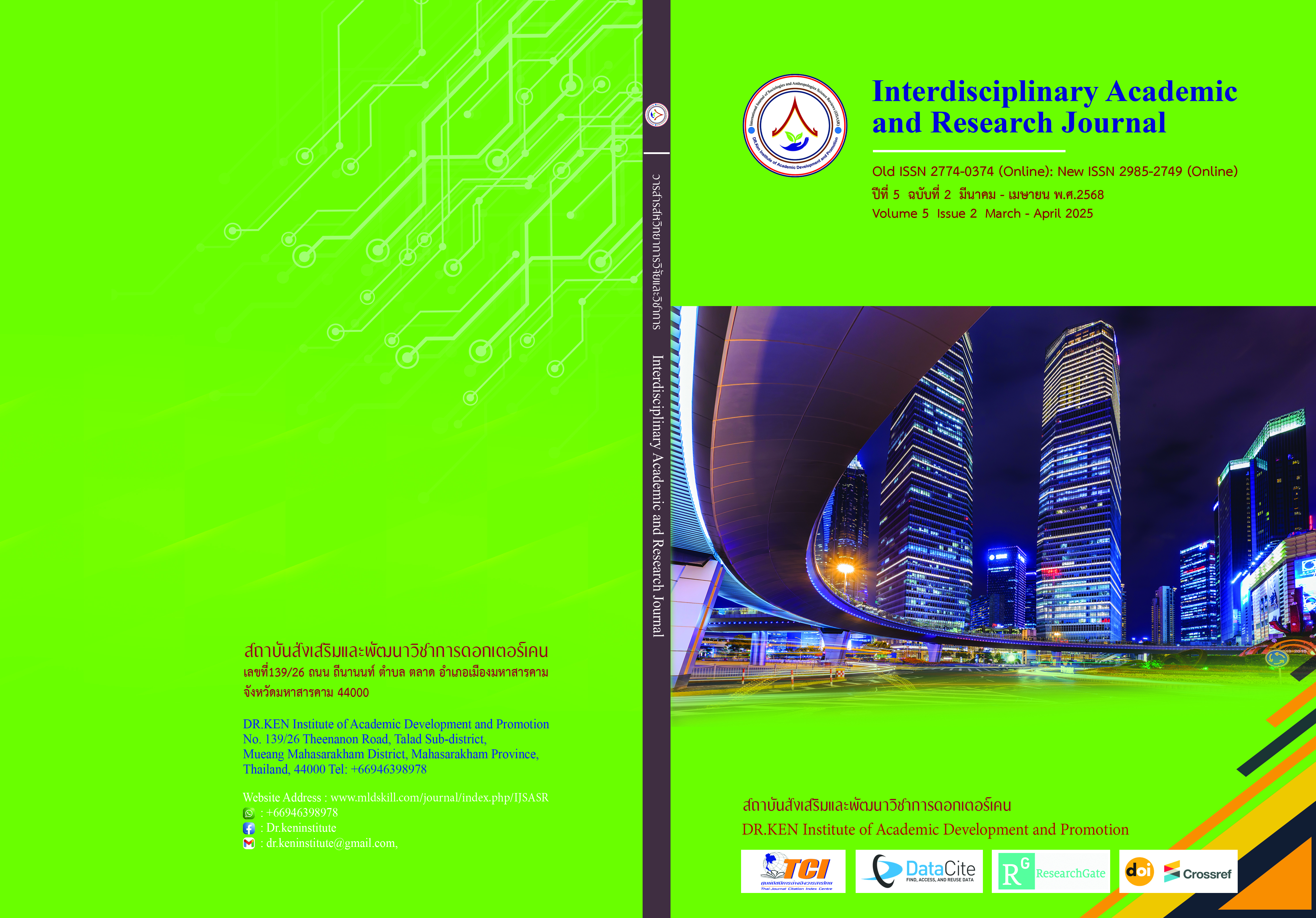The Development of Thai Language Pronunciation Skill with the Tonal Conjugation of Three Groups of Letters Exercises Practicing for 7 Grade
DOI:
https://doi.org/10.60027/iarj.2025.280570Keywords:
Conjoining 3 Groups Consonants, Thai Reading Comprehension Ability, Thai LessonsAbstract
Background and Aims: The importance of pronunciation in Thai is significant for communication, whether in academic contexts or storytelling. Due to the unique combination of consonants and tonal marks in Thai, words with different tones can have distinct pronunciations and meanings. This has led the researcher to focus on pronunciation, as most students encounter issues with pronunciation that can sometimes cause communication problems. The objectives of this research are: 1) To study the ability to pronounce Thai words in the subject "Thai Literature Properties" among Grade 7 students. 2) To compare the pronunciation abilities of Thai words before and after learning the subject "Thai Literature Properties" among Grade 7 students.
Methodology: The research follows a pre-experimental design with a one-group pretest-posttest design. The target group consisted of 114 students from Grade 7, during the second semester of the 2022 academic year at Surawiwat School, Suranaree University of Technology. Data was analyzed using basic statistics, including descriptive statistics (frequency, percentage) and inferential statistics using a dependent samples t-test.
Results: The research findings are as follows: 1) 7th-grade read aloud 45 words, divided into three groups: middle, low single, and low double letters. The most accurately pronounced letters are the middle letters Jig (จิก), while the most inaccurately pronounced letters are the middle letters Kwan (กว๊าน), followed by the high letters Fang (ฝาง). 2) 7th-grade students' pronunciation of the Thai language after using is higher than before using, with an average score of 44.66 and a standard deviation of 1.04 after, compared to an average score of 41.66 and a standard deviation of 2.67 before teaching.
Conclusion: Students often mispronounced words in the following categories: 1) middle consonant group, such as "กว๊าน" and "กว้าน", 2) high consonant group, such as "ฝาง", and 3) low consonant group, such as "ฟ่าง". When the researchers compared the scores obtained from the pronunciation practice of the three consonant groups, it was found that the average pronunciation score of the three consonant groups after learning was significantly higher than before learning.
References
กระทรวงศึกษาธิการ. (2551). หลักสูตรแกนกลางการศึกษาขั้นพื้นฐาน พ.ศ. 2551. โรงพิมพ์คุรุสภาลาดพร้าว, กรุงเทพฯ.
กฤตวิทย์ ดวงสร้อย. (2522). หลักภาษา. โครงการบริหารวิชาการ มศว, สงขลา.
กัลยา ติงศภัทิย์, ม.ร.ว. (2533). วรรณยุกต์ในภาษาไทยถิ่นสุพรรณบุรี: การศึกษาเปรียบเทียบวรรณยุกต์ในคำกับวรรณยุกต์ในถ้อยคำต่อเนื่อง (รายงานผลการวิจัย). ภาควิชาภาษาศาสตร์ คณะอักษรศาสตร์ จุฬาลงกรณ์มหาวิทยาลัย.
สนิท สัตโยภาส. (2545). ภาษาไทยเพื่อการสื่อสารและการสืบค้น. บริษัท 21 เซ็นจูรี่จํากัด, กรุงเทพฯ.
สำนักงานคณะกรรมการการศึกษาขั้นพื้นฐาน. (2552). แนวปฏิบัติการวัดและประเมินผลการเรียนรู้ ตามหลักสูตรแกนกลางการศึกษาขั้นพื้นฐาน พุทธศักราช 2551. กรุงเทพมหานคร:โรงพิมพ์ชุมนุมสหกรณ์การเกษตรแห่งประเทศไทย จํากัด.
โสภัทรา คงทวี. (2557). ผลการจัดการเรียนรู้โดยใช้แบบฝึกทักษะการอ่านออกเสียงคำควบกล้ำ ร ล ว กลุ่มสาระการเรียนรู้ภาษาไทย สำหรับนักเรียนชั้นประถมศึกษาปีที่ 4. วิทยานิพนธ์ครุศาสตรมหาบัณฑิต. กรุงเทพฯ: มหาวิทยาลัยราชภัฏธนบุรี.
องค์อร จันทร์พูล. (2558). การพัฒนาแบบฝึกทักษะเพื่อส่งเสริมทักษะการอ่านคิดวิเคราะห์สำหรับนักเรียนประถมศึกษาปีที่ 3. วิทยานิพนธ์ปริญญาการศึกษามหาบัณฑิต. มหาวิทยาลัยมหาสารคาม, มหาสารคาม.
Downloads
Published
How to Cite
Issue
Section
License
Copyright (c) 2025 Interdisciplinary Academic and Research Journal

This work is licensed under a Creative Commons Attribution-NonCommercial-NoDerivatives 4.0 International License.
Copyright on any article in the Interdisciplinary Academic and Research Journal is retained by the author(s) under the under the Creative Commons Attribution-NonCommercial-NoDerivatives 4.0 International License. Permission to use text, content, images, etc. of publication. Any user to read, download, copy, distribute, print, search, or link to the full texts of articles, crawl them for indexing, pass them as data to software, or use them for any other lawful purpose. But do not use it for commercial use or with the intent to benefit any business.














.png)

